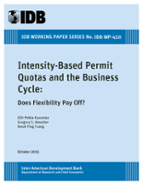Intensity-Based Permit Quotas and the Business Cycle: Does Flexibility Pay Off?
Date
Dec 2013
Tradable permit markets for carbon dioxide (C02) emissions respond to short-run fluctuations in economic activity. To provide stability, both price and quantity interventions have been proposed. This paper focuses on the relative performance of fixed versus intensity allowances in the presence of both productivity and energy price uncertainty. Both instruments achieve the same steady-state emissions reduction target of 20 percent, which is similar to the current policy proposals, and the regulator then chooses the allowance policy that has the lowest expected abatement cost. A standard real business cycle (RBC) model is used to solve for the expected abatement cost under both policies. Expected cost outcomes are compared using data from the U. S. economy as the baseline scenario. Unlike previous studies, this paper's results show that, under a reasonable model calibration, fixed allowances outperform intensity allowances by a cost difference of as much as 30 percent.



